Category Archive for Fashion
Eco-travel attractions in Langkawi, Malaysia! Mangrove forest nature boat tour, sailing with Casa del Mar hotel.
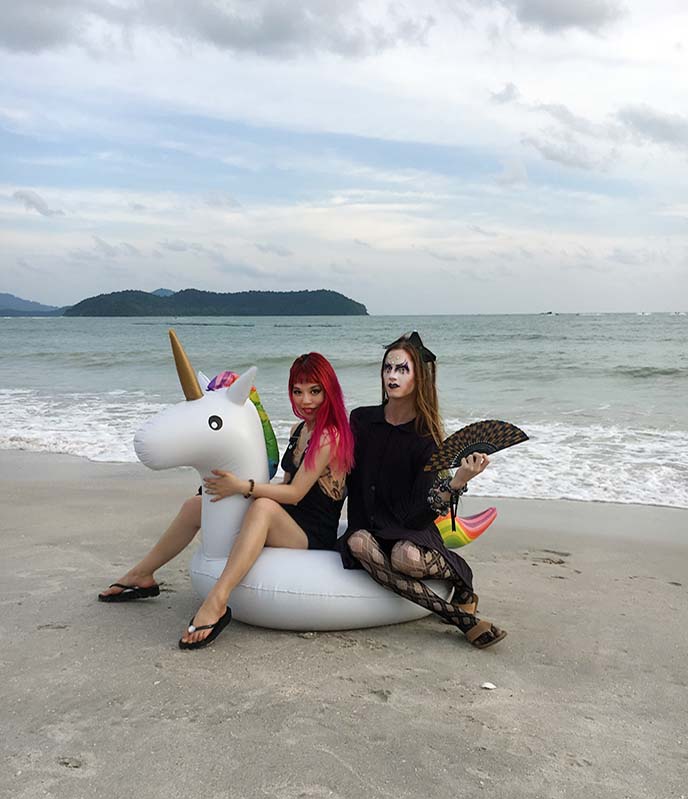
Straddling a rainbow unicorn — that’s how we ride-or-die!
I think it’s fair to say… Yukiro and I had a magical time at our Malaysia beach resort, Casa del Mar Langkawi.

If you didn’t catch our first post, come take a look: we did a fun review of Casa del Mar.
In Part 2, we’ll venture beyond the hotel and see Langkawi’s famous natural attractions. We joined an eco-tour that let us witness monkeys, eagles, mangroves and caves filled with bats! The hotel staff even took us to their private beach by boat… and I couldn’t resist drawing a pentagram into the sand.

We spent several glorious days relaxing at Casa del Mar, a luxurious yet down-to-earth resort on Pantai Cenang beach. Our villa was footsteps from the beach, so we spent a great deal of time playing in the warm waves of the Andaman Sea.
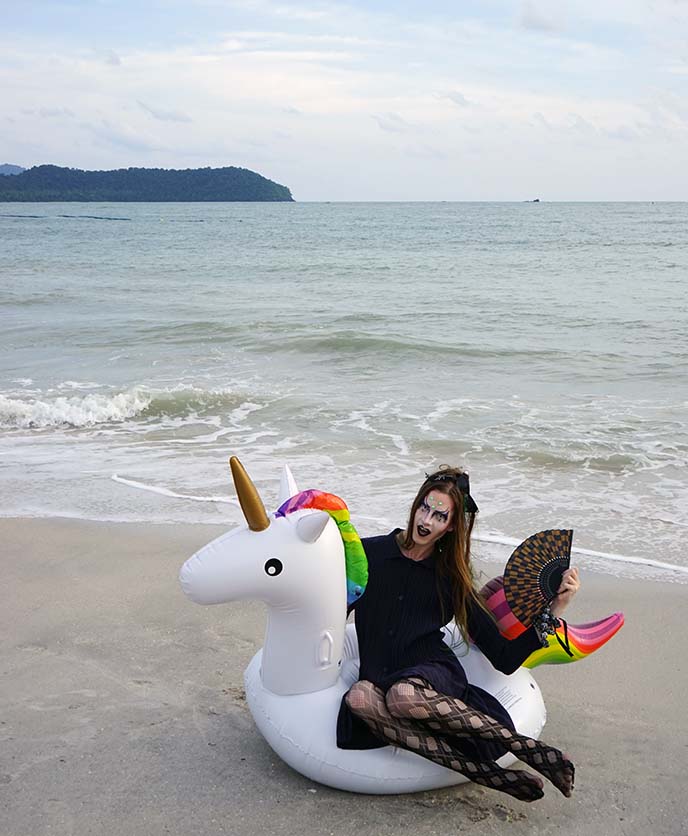
Yukiro and I met an Asian couple with an inflatable unicorn floaty. They were kind enough to let us sit on the mystical creature — complete with a golden horn, rainbow-colored mane and tail!
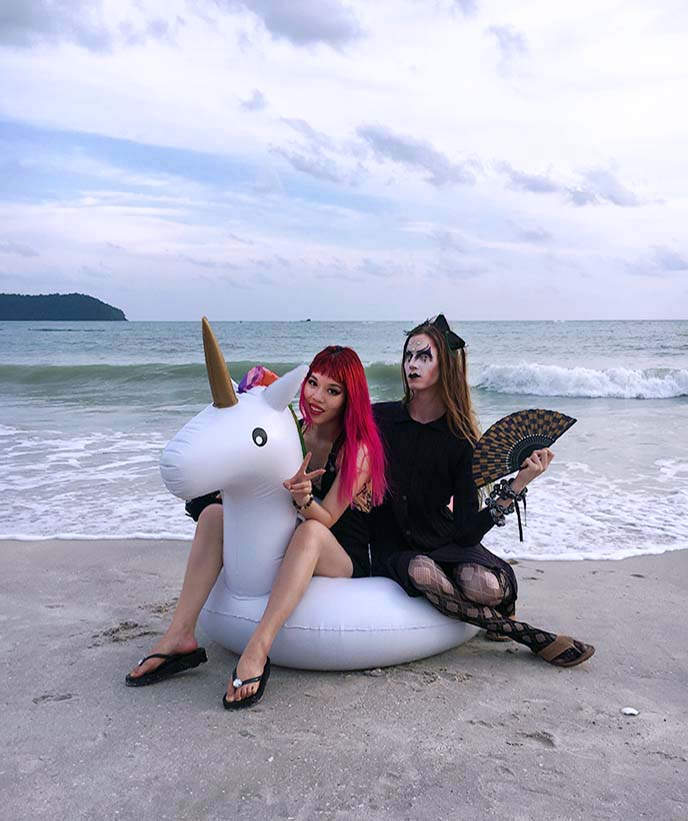
Isn’t this the cutest swimming pool lounger? This exact unicorn float is for sale here and below (click thumbnails for details).

Yukiro and I could have hung out all day at Casa del Mar, sipping dragonfruit cocktails and lounging on the beach. However, we always like to mix it up, and get out to see the local life.
Langkawi, Malaysia is known for its incredible nature… so the hotel generously set us up on an ecological day trip with Dev’s Adventure Tours.

Dev’s Adventure Tours is a local company, with fluent guides who are clearly passionate about preserving and appreciating their natural surroundings. They offer a variety of tour packages that let you get close to the flora and fauna of Langkawi, without harming the environment. These include kayaking, cycling, jungle treks… but as you might guess, we “non-sporty types” went for a half-day boat ride through the mangroves and islands.
The tour company picked us up in a group shuttle in the morning. We soon arrived at Kilim Karst Geoforest Park, where we found ourselves surrounded by spectacular limestone caves and lush foliage.

When Yukiro and I heard that we’d be seeing Langkawi bats in a cave, we literally cheered! Our guide Kieran brought us into a deep cave, and briefly shone up a flashlight so we could see this Gothic sight: a colony of black bats, hanging upside-down from the ceiling.

The “Kelawar Cave” or Bats’ Cave is about 60 meters long, and located in the heart of Kilim mangrove swamps. Hundreds, if not thousands of these vampiric creatures live inside.
The sign outside describes how important they are to the ecosystem, particularly by aiding pollination and keeping insect populations at bay.

The bats truly look like like Count Dracula, wrapped in capes…. and waiting to suck your blood!

But seriously though: these Malaysian bats feed mainly on fruits. Our guide explained that there are three different species that “hang out” here, and ways we could identify them (body size, shape of nose). The biggest danger is accidentally touching their guano or excrement, but the cavern is well maintained by the geo-park staff.

We also admired the cave’s dramatic stalactites (that “hang tight” from the ceiling) and stalagmites, which come together to form a single curtain. These eerie formations look like alien teeth, or something from the mind of H. R. Giger.

Outside, our guide Kieran pointed out a pit viper snake with an arrow-shaped head. We stepped carefully towards it: sudden, close movements might make the serpent pounce and inflict a venomous bite.

We took a brief walk through the forested paths. Many species live in Kilim Karst Geoforest Park, and can be heard or spotted: otters, birds, tree crabs, lizards.

Looks like this monkey is mooning us! These long tailed or crab-eating macaques are a common sight in Langkawi, Malaysia.

These fuzzy creatures have become accustomed to humans, which makes them rather naughty. They have bite, and come up to steal food and water bottles from visitors — so be prepared.

It’s too bad that many tourists are careless or unaware, and try to feed the monkeys. It’s best to leave the macaques to their natural behaviors and watch them from afar. (Not a bad place to get a back-scratch.)

Our group got onto the small boat, and we sailed past Langkawi’s limestone cliffs, tropical foliage and warm beaches. I loved watching the scenery pass by from the bow.

We got up-and-close with the mangrove forests: these intricate networks of roots, trees and water that form a dynamic ecosystem. The habitat houses all types of creatures, and protects coastlines from strong waves and winds.
Kieran reminded us of the devastating 2004 tsunami in Malaysia; thanks to the natural barriers of the mangroves, Langkawi was saved from much of the destruction.

He and the captain had a keen eye for spotting camouflaged creatures. He pointed out a blue kingfisher (tiny colorful bird found in Southeast Asia), and this spotted snake (can you see it, disguised as a branch in the middle of the photo)? On some tours, guests even see sharks and dolphins.
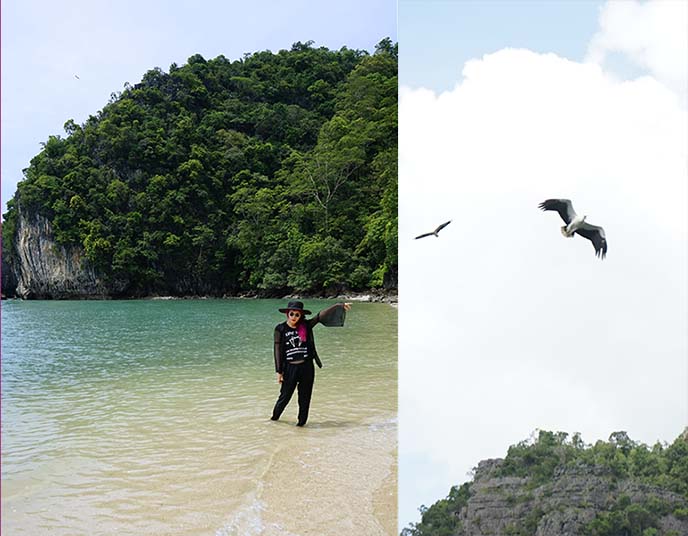
The boat sped up, and we went further out into the Andaman Sea. We watched giant eagles swoop and dive into the waters — such majesty! In Langkawi, there are two species: white-bellied sea eagles and Brahminy kites.
Dev’s Adventure Tours puts eco-preservation first, and therefore doesn’t feed the eagles. It’s important that these powerful birds are not dependent on humans, for the sake of the next generations.

Out to sea. We stopped by a secluded island with a white sand beach. Yukiro did a hand-stand in the waters!

Our crew ended the day with lunch, which was included in the boat trip package. Cheers to Dev’s Adventure Tours for the knowledgeable, eco-focused tour of Langkawi’s mangroves and wildlife.
As we waited for our pick-up, I couldn’t resist snapping this photo. How interesting to see the way many Muslim women dress on vacation: full-coverage burkas and sunglasses! I don’t know how they powered through the sweltering heat.
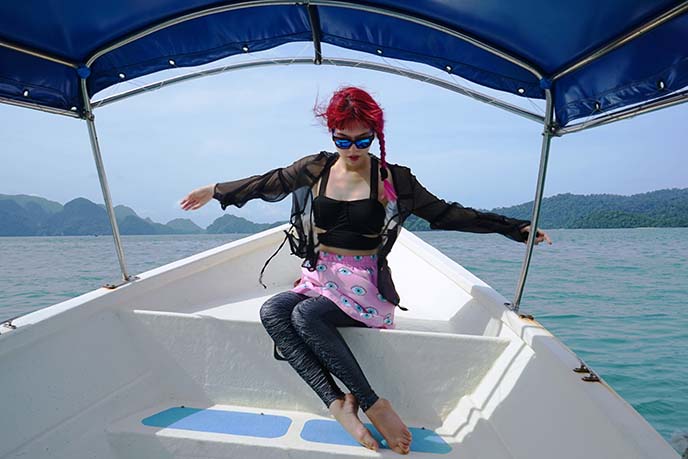
Another day, another adventure. Our hotel Casa del Mar Langkawi offers their own experience packages for guests as well. These activity options include a fishing trip and castaway beach picnic. We went for “Island Hopping,” as we were keen to see more of Langkawi’s 99 isles.
Casa del Mar drove us to a local pier, and our captain took us sailing on a private boat.

Close-up on my blue-eyed skirt: it’s from Print All Over Me and designed by Coucou Suzette. To avoid bug bites, I always cover my limbs in these climates: I’m wearing Joy Division Unknown Pleasures leggings.
Yukiro and I sailed past the Lake of the Pregnant Maiden (Pulau Dayang), which has a mountain range that resembles a pregnant belly. Our captain told us about the mysterious legend, and how many women come here to increase their chances of fertility.

We said hello to the eagles, and set anchor at Casa del Mar’s private beach. I loved the Robinson Crusoe feeling of being alone on an island (I made my mark, by drawing this pentacle into the sand!) Our captain brought out a cooler filled with juices, fruits and sandwiches; we enjoyed a picnic lunch on the beach, followed by a swim and sun-bathing.
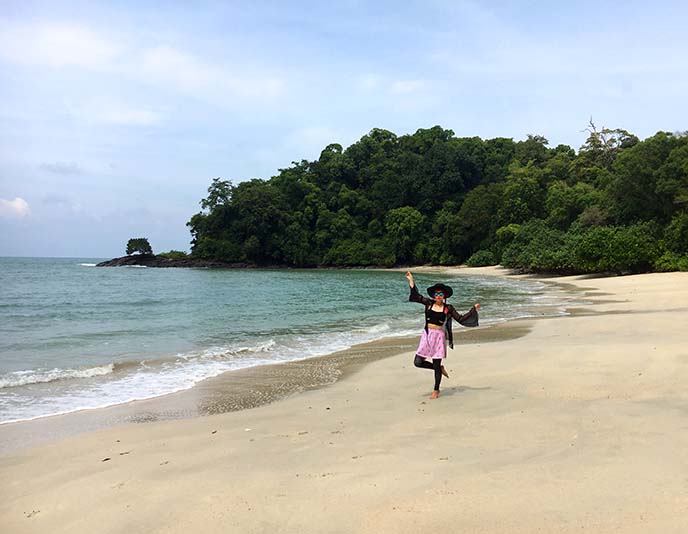
We also made a stop at Dayang Bunting Marble Geoforest Park, where visitors can rent swan-shaped boats to take out into the lake. However, I wasn’t fond of the touristy feeling of that place; my happy place is on a private Malaysian beach like this one!

For those who love to get deep into nature, Langkawi is a wonderful destination. I encourage you to tread lightly and take an educational tour, as it’s important to preserve the local wildlife while we can.
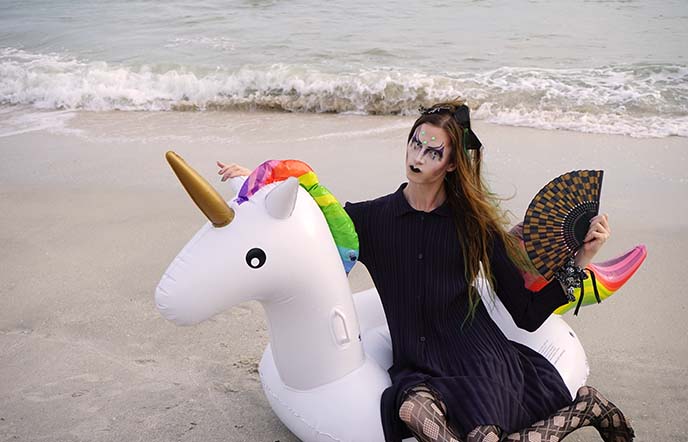
Did you have fun reading about our Casa del Mar Langkawi adventures? Have you ever seen bats or monkeys up-close, like we did?
(PS – you can get this fun unicorn floaty here and below, you know you want one!)
SHARE & COMMENT
Visiting the Acropolis of Athens in off-season! Parthenon of Athena, ancient Greece archaeology museum.

“Acropolis Now!”
Flashback to Athens, Greece and pirouettes of joy… I’m on my way to the Parthenon, the iconic temple of Athena and symbol of the city.

Photographer Joey Wong and I visited Athens during the off-season, which we recommend for multiple reasons. Ticket prices are cheaper, the weather is not too hot, and there are fewer tourists around — meaning you can take your time to explore, and get marvellous photos without anyone in the frame.
We hope you enjoy these outfit photos, inspired by Greek goddesses and shot amidst ancient ruins.

The Acropolis looms over the city, and is impossible not to recognize. (This citadel includes the famous white-columned Parthenon, as well as the 5th century Propylaia, Erechtheion and Temple of Athena Nike.)
Get into an Uber or taxi (prices are cheap in Athens), and have the driver drop you off at the foot of the hill. Then, it’s a short walk up to the main entrance and ticket booth.

Monastiraki, the neighborhood at the base of the Acropolis, is worth spending time in. This classic area has cobblestone paths with whitewashed houses, outdoor cafes, and pockets of nature.

As you walk up to the Acropolis, which means “highest point,” you get the sense that you are ascending Mount Olympus — mythical home of the Greek gods.

Athens is an ideal destination for those who love ancient culture, myths and art.
The capital has been inhabited for 2500 years, and archaeologists are continuing to uncover surprising artifacts.

That day, I wore a white ballerina skirt — a tribute to the flowing robes worn by the ancient Greeks. My black ballet crop top is by Morph8ne, and my sunglasses are Moat House.
(Click below for more from this Gothic designer):

We came in late March, which is right before the start of the tourist season. The timing was ideal: the sun was out but it wasn’t overly hot, and the attractions weren’t crowded.
Packing tip for Athens: bring sunglasses, wear layers (it gets chillier at night in the spring), and choose shoes that are great for walking (the Acropolis has a rocky ground).

Normally, the entrance fee to the Acropolis is 20 Euros — but from November 1st to March 31st, it’s half price! There is also a “multi-site ticket” for €30, which is valid for 5 days, and lets you visit this and six other archaeological sites.
It’s not possible to buy tickets online (unless you go with a guide), so give yourself plenty of time to line up at the main ticket office. Once again, we were glad we came in the off season, since the wait only took 10-15 minutes and the weather was pleasant.

My friends and I chose the 10 Euro entry, which let us access the Citadel, North and South slopes (and all the main structures). We loved walking slowly up to the Parthenon, taking in the sights along the way.
One of the first ruins we encountered was the Theatre of Dionysus Eleuthereus. If we were here in the height of summer, it would be impossible to take photos without others in the background.

No need to hire a guide for the Acropolis, as there are many explanatory signs along the way. What a treat to view these two-thousand-year-old remains right up close, in their original environment.

My outfit of the day is inspired by the Greek goddesses. This Morph8ne long sleeve shirt and other items are available below (click to see):

I felt as if I were channeling Athena, as I looked over the grand theater.
For those who aren’t familiar with the mythology, she is the Greek goddess of wisdom and war. The calm-tempered Athena only fought for just causes, and helped out heroes including Odysseus, Jason, and Hercules.

Originally, there were several temples dedicated to Athena in this same location, lost and rebuilt throughout time.
During the Golden Age of Athens (460–430 BC), the Parthenon and other famous temples were built to honor Athena — and still remain standing, to this day. This project was led by Pericles and brought to life by the sculptor Phidias, and architects Ictinus and Callicrates.

The Odeon of Herodes Atticus is a stone theatre on the southwest slope, with a remarkable “ancient meets modern” look. It was completed in 161 AD, but damaged by east Germanic tribes in 267 AD.
The Odeon was renovated in 1950, and remains an active concert venue with a capacity of 5000 (the Tokyo Ballet and Maria Callas have performed here).

I’ve actually been to the Acropolis years ago — but it was during the peak of summer, and I felt stifled by the tourists and humidity. This time, I avoided the busy season, and the experience was a million times better.
You can see me walking through this historic UNESCO site, in our travel video about Athens, Greece. Please take a moment to watch by clicking above, or see it on @LaCarmina YouTube.

Instead of being pressed along by the crowds and searching for shade, I was able to take my time to wander. I could stop to read the placards, take unobstructed photos, and truly enjoy the sights. Plus, as you can see, the weather was pure “nectar of the gods.”

So many epic viewpoints, as the elevation gets higher…

Almost at the top! I’m standing right below the Propylaia, or monumental entrance to the Acropolis. It is a majestic entryway, with colonnades in the Ionic and Doric styles.
(My faux python purple clutch is by Makeup Junkie Bags.)

Walk through the Propylaia, and there she is… The Parthenon! The symbol of ancient Greece, democracy, Western civilization and culture.

Obligatory photo in front of the Parthenon, on the Acropolis. It’s apparently one of the most Instagrammed travel destinations.

The Parthenon has been through a lot, to put it mildly. After the fall of Greece, it was used as a Byzantine church, a Cathedral under the Venetians, a mosque during the Ottoman Empire rule, and even a harem.
In 1687, it was significantly damaged by an explosion. In the early 1800s, Lord Elgin stripped most of the sculptures and put them in the British Museum, where they mostly remain today.

Despite all this, the pillars stand strong. The architects of the Acropolis were very much ahead of their time.

Next to the Parthenon, it’s easy to spot the Erechteion — a temple dedicated to both Athena and Poseidon. The north side features the famous “Porch of the Caryatids,” or six Ionic columns carved to look like Greek maidens. (That’s quite the load they are carrying on their heads!)

These are actually plaster copies of the caryatid sculptures. A few of the originals are preserved in the Athens Acropolis Museum, while others are in the British Museum.
The Greek government is still trying to get the “Elgin marbles” returned to the Acropolis, but it is a slow process. Fortunately, many other museums and collectors worldwide have sent back pieces.

When you look out over the city from the cliff, it’s easy to understand why this has been a spiritual site for millennia.

I recommend coming to the Acropolis early in the day, so that you can catch the light and take your time to explore.

I grew up reading stories about the Greek gods, and enjoyed seeing how the mythology was woven into the landscape of Athens.
Above is the Areopagus, or Ares Rock. Ares (the god of War) was supposed to have been tried here for the murder of Poseidon’s son Halirrhothius.

In another story, Ares was fighting the local Greeks on the mountain. Athena felt he was being unjust, so she hurled a giant rock at him and knocked him out cold — which you can still see on the top of the hill today.

One of my favorite gods is Dionysus (I’m standing in his stadium). He represents wine, fertility and ritual madness.
The wild festivals that celebrated him also spurred the development of Greek theatre.

Outside the Acropolis, we stopped for ouzo and Greek snacks.

Then, we took a short walk to the new Acropolis Museum. (Address: Dionysiou Areopagitou 15, Athina 117 42)
This archaeological museum opened in 2009, and focuses on artifacts found during Acropolis excavations. From the Bronze Age to the Roman and Byzantine empires, the exhibitions show the many layers of history found in this important site.

The museum is beautifully designed, with lots of natural light. Visitors are encouraged to see the remains in chronological order, and learn about the works from multi-media displays (such as 3D renderings of “kouroi” statues of nude male youths).
On the right, I got to see the original Caryatids up close, and watch a video about how they restored the marble with laser technology.

We reached the top level at sunset, which let us take in this 360 view of the Acropolis and mountains.
This uppermost level re-creates the frieze of the Parthenon, with both plaster and original pieces. Visitors can walk around and see the carvings in their original position, which depict the Great Panathenaia festival for the Goddess Athena.

Talk about a perfect day in Athens! I’ll remember this trip for years to come.
The Acropolis is beautiful any time of the year, but I suggest that you come in late spring or late fall for a quieter, more leisurely experience.

You can find more Athens tips at DiscoverGreece.com, a great resource for planning a trip here.
I leave you with our Athens travel vlog, which features the Parthenon as well as the modern side of the city. Please also take a moment to watch — I hope it inspires you to come to Greece.


 LA CARMINA
LA CARMINA






